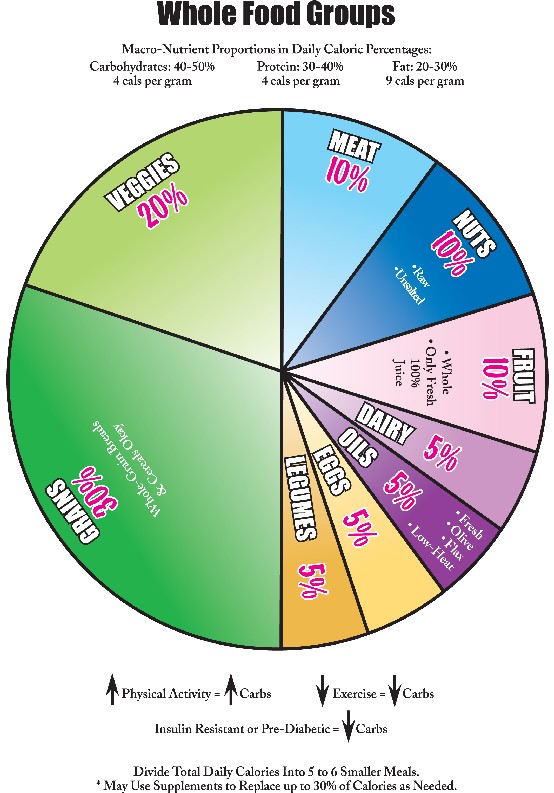
Whole-Food Groups Pie Chart
Originally created by Max for Destination Health Plus LLC, copyright 2007, all rights reserved

Like our Balanced-Body Pyramid, the DHP Whole-Food Groups Pie Chart is a clear and concise method to effectively present the main themes of our eating plan. Specifically in our pie chart we are addressing whole foods, meaning as unrefined and as close to nature as you can get. This does not mean we are eliminating all processed or prepared foods, such as pastas, or casseroles. This just means we want you to emphasize whole-foods in your diet.
We also address the most ideal way to divide up your daily calories: 40-50% carbohydrates (4 cals per gram); 30-40% protein (4 cals per gram); and 20-30% fat (9 cals per gram). This ensures you will meet your sustained energy needs for performance with complex carbs; you will meet your protein requirements for muscle maintenance and tissue repair; and meet your minimum fat requirements.
The type of carbohydrates you choose and how you combine your foods is very strategic so that you can moderate your insulin and make it work efficiently so that you will have sustained energy throughout the day. This is why we emphasize complex and whole-grain/unrefined carbs, for higher fiber contents and slower digestion. You can also combine your carbs, proteins, and fats during meals for an over all lower glycemic load, so that insulin release is slowed and minimized. The high fiber content of complex carbs is essential for making you feel fuller, maintaining colon function and cardiovascular health. In our book, ‘How Much Fat are You Carrying?’ we also discuss food-combining during meals to facilitate ideal digestion, as well as providing you with a glycemic index of foods chart in the appendix.
Whole-fruit is the only simple-carbohydrate, or sugar, we emphasize daily, because it is packed full of phyto-nutrients, fiber, anti-oxidants, cancer fighting flavonoids, and, it can really satisfy a sweet tooth! As you will learn in our book, it is ideal to eat fruit by itself since it comes from nature with its own digestive enzymes, and if you eat it with a large meal, the fructose and fiber can start to ferment in the stomach until all the other food is digested (leading to gas and discomfort).
However, under our DHP meal plan guidelines we do NOT require that you eliminate ANY food groups. We believe everything is ‘legal’ within moderation. In fact we encourage you to have an occasional cheat meal to satisfy your cravings for must-have foods that other diets ban. This is because one cheat-meal keeps your sanity, prevents out of control binging and follow on guilt, and, may even have the added benefit of boosting your metabolism, since chronic low-calorie dieting suppresses your metabolism and can drive your body into starvation-mode.
Not restricting or counting calories is another key principle under our DHP eating plan: Ultra low-calorie diets bog down your metabolism, and let’s be honest – counting calories at each meal is difficult and a down right pain in the butt! However, we do apply portion control and moderation because after all, total-caloric intake is a factor in weight gain. But we do this through training your natural-intuition and practice gauging portion size, not counting calories. You will begin by dividing up your daily food-intake into 5 or 6 smaller meals/snacks and eat every 3 hours or so, never feeling too full, but eating just enough to take away the hunger. Your stomach should never feel stuffed, or bloated, or heavy. After you eat a meal if you still feel very hungry, give your mind and appetite a few minutes to catch up with your stomach and it should go away. If not, simply eat some more veggies, or drink more water, or a cup of Green tea or coffee. The extra (calorie-free) volume filling your stomach WILL then shut down the hunger signal. Another trick is a few raw nuts after a meal: the healthy fat from the calorie-dense nuts will satiate you but with no additional insulin impact.
Lastly, we allow more carbs than most current diet plans, but that is because we expect you to exercise or at least be active 5 days per week. Because when you exercise carbohydrates once again become a welcome food group, and in fact, are the body’s preferred source of fuel for any kind of intense exercise, (exceeding 75% of your max HR), as well as for strength training. So if you are exercising consistently then you get to enjoy additional carbs…imagine that! And if you take a rest day or are too busy to exercise one day, then simply reduce your carbs and substitute in more protein or unsaturated fats.
Again, this is just a brief summary of our DHP eating plan and the pie chart. We do hope that you will by our holistic fat-loss book, ‘How Much Fat are You Carrying?’ for a complete and in depth explanation of the ideal methods to eat to set your metabolism on fire, making it virtually impossible for your body to store fat. That’s right – you can re-program your physiology and restore your insulin function and sugar metabolism by applying the techniques we teach in our book.
Best of luck to achieving your new, healthy, and leaner body, and let us help you on your journey!
Links: Back to Max's Training Page! Back to Max's Home Page!
To www.destinationhealthplus.com!